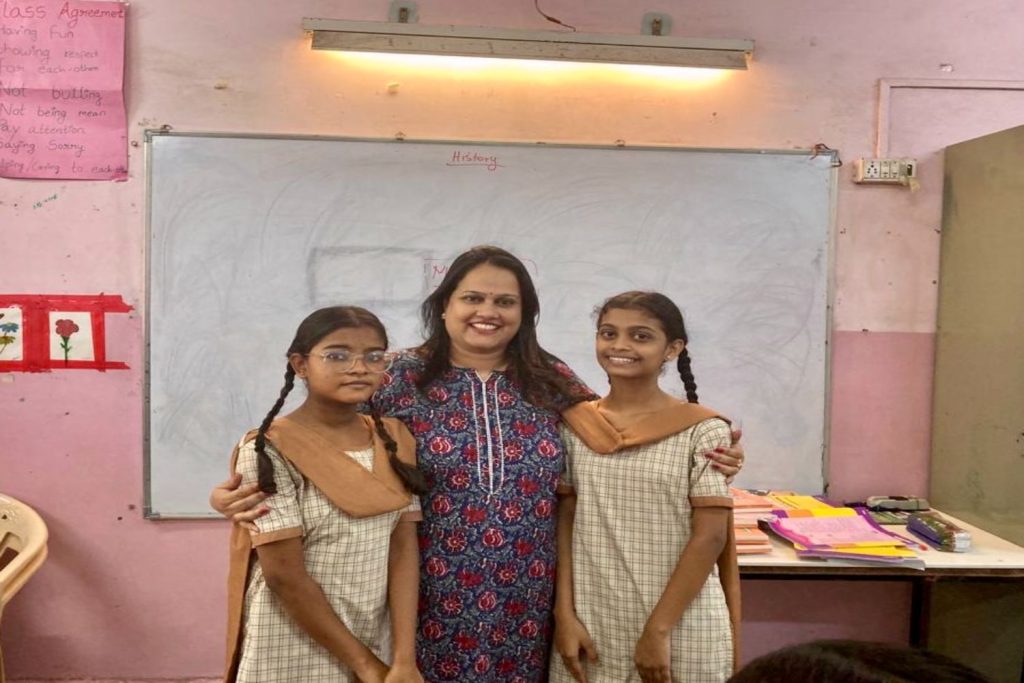Laying the groundwork of education – How a school leader sets up a school for success
In an article titled “Laying the groundwork of education,” Shraddha Agarwal shares how school leaders are co-creating communities consisting of stakeholders in school education, to effectively collaborate for student well-being and learning outcomes

Education is the foundation of progress. School leaders are the architect of that foundation. The effect of an influential leader translates into the growth of an educational institution, and moves from teachers, to students, to parents and their communities. In every aspect, the leader with their behavior and a learning mindset sets the tone for the school.
Akanksha Foundation runs 10 schools in Mumbai city, in partnership with Brihanmumbai Municipal Corporation (BMC). Sheetal Murudkar, Director of School at Akanksha, Mumbai, believes every school leader needs to spend at least the first six months in vision setting in consultation with teachers, parents, the government and other stakeholders involved.
“Running a school is no less than a prime minister running the country. It is very challenging but also immensely enriching. At Akanksha, all school leaders are aligned and working towards one vision – one day, all children will be equipped with the knowledge, skills and values they need to lead empowered lives. They are striving to make full human beings out of their students, and help them achieve their highest potential, both academically and socially,” says Sheetal.
There is enough written on the importance of teachers, but what drives a school to success is the leader holding all the parts together. According to Sheetal, an effective leader is one who can prioritize the most important tasks and is also able to create a second line of leadership. With the amount of responsibilities on a school leader’s desk, it becomes important to not lose sight of the larger vision. This can only happen when all stakeholders are able to play their parts while a school leader manages and monitors them.
School leaders as agents of change
“Before making any decisions, it is important for leaders to involve children in conversations that will impact them. I encourage all school leaders to spend time outside school for a few hours to objectively look at what other systems are working and what the gaps are. It gets difficult when you are caught in a vortex managing affairs internally,” adds Sheetal.
For Akanksha, one of the biggest wins are their school leaders, who have spent more than 10-15 years in a dedicated manner to achieve the schools’ vision. Sheetal says, “They are all visionary leaders, willing and open to learning at every opportunity. We have a very evolved leadership with students’ academic, emotional and social well-being at the center.”
School leaders play a crucial role in managing administrative affairs, fostering a collaborative environment, and creating a positive learning space for both teachers and students. This eventually helps in achieving the school’s mission and vision. However, the challenges of running a successful school are plenty. Mandira Purhohit, a school leader at The Akanksha Foundation for over a decade, understands these challenges the best.
In the past year, the Akanksha-run Sitaram Mill Compound Mumbai Public School (SMCMPS) has had to adapt and adjust to continuously changing circumstances. Their school leader, Mandira, was recently faced with the uphill task of vacating their school premises overnight and shifting to an entirely new location. Despite pushback from parents and communities due to the change in the school’s location, Mandira persisted through it all. She marshaled all the resources, motivated the teachers, and ensured that new classrooms were up and running within a week. The teacher even went above and beyond to decorate the classes, put up posters on the walls, and helped students settle into their new classrooms.
As a school leader, she faces new battles every day. “From increased learning gaps due to COVID-19 to lack of staff in the school, has left us all stretched beyond our limits. It gets exhausting, but it’s also rewarding to see our children turn into such special human beings who are still very much connected to us. This I feel has only been possible due to each and every teacher in the school,” says Mandira.
The paucity of adequate numbers of good teachers is one of the biggest challenges in India’s public education system. This lack has substantially affected the ability and performance of teachers as they are overextended trying to fill this gap. “Teachers often get caught up in admin work which gives them less time to innovate and pay attention to each student in the class. Teacher vacancies have led to us school leaders teaching classes,” adds Mandira.

Collaborating with stakeholders for student well-being
Mandira strongly believes that the education provided in public schools should be on par with the private education system. Along with academic outcomes, a strong team culture is required. She says, “Whatever I expect from the team, I first do it myself. I do the remedial work with them. For instance, after COVID, we were focused so much on [academically] struggling kids that we didn’t pay much attention to students at the top quartile.”
In Akanksha schools, the school leaders and teachers ensure equal participation by the community. Parents have been a strong pillar in the holistic development of their children with the help of social workers, helpers and other staff. In SMCPMS, Mandira has partnered with many external partners like Music Basti and Lighthouse Foundation, and conducts monthly events that focus on students’ mental well-being.
“It is important for children to have a strong pulse on their mental state. These workshops help students get exposure and build a strong rapport with parents and other members of the community. There have been many instances where communities have rallied and gotten the help required for their children. Thirteen years ago, this is also how our school came to be. The parents saw their children studying at an Akanksha center and insisted that we start a school in their community.”
Giving back to the school community
Under Mandira’s leadership, SMCPM has a strong volunteer involvement. Since the inception of the school, there have been volunteers both in the form of the alumni and people from outside the community who come and give their valuable time at the school.

One such volunteer, Nalini Panday, has been teaching at the school for the past 20 years. There are alumni who have been running different clubs (yoga, self-defense, handwriting, etc.) at the school and are very committed to giving back.
“Given that our kids come from underserved communities, the challenges are multifold. But I believe in setting the bar similar for these kids as my two biological children and others from privileged backgrounds. It also means learning for us at every stage. When our donor, Apple, gave us iPads, I was paranoid about giving them out to our students. But then we all took training and over time learnt how to make use of it. Only when we learn ourselves first can we expect the best outcomes from our students,” says Mandira.
Similar to the expectations from a prime minister, school leaders also need to be innovators, problem solvers, learners and role models themselves. From corridors being converted into counseling rooms to alumni substituting for teachers, school leaders deal with issues ranging from infrastructure to managing community problems in the middle of the night. It is a 24/7 job, which, in the end, inspires and changes lives, one student at a time.



No approved comments yet. Be the first to comment!